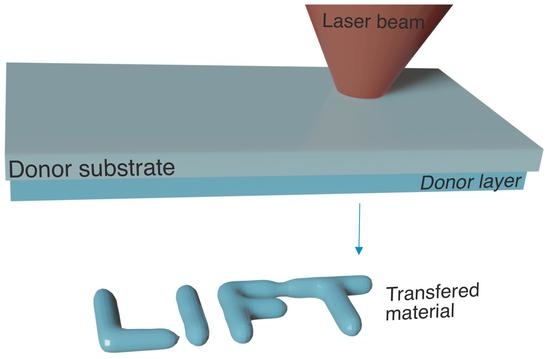Printing via Laser-Induced Forward Transfer and the Future of Digital Manufacturing
Abstract
:1. Introduction
2. A Brief Overview of the Laser-Induced Forward Transfer (LIFT) Technique
2.1. LIFT from Solids
2.2. LIFT from Pastes
2.3. LIFT from Liquids
3. LIFT Scientific Literature
4. Industrial Perspectives
4.1. Patent Applications Landscape
4.2. Commercial Forecast and Future Trends
Supplementary Materials
Author Contributions
Funding
Institutional Review Board Statement
Informed Consent Statement
Data Availability Statement
Acknowledgments
Conflicts of Interest
References
- Serra, P.; Piqué, A. Laser-Induced Forward Transfer: Fundamentals and Applications. Adv. Mater. Technol. 2019, 4, 1800099. [Google Scholar] [CrossRef] [Green Version]
- Morales, M.; Munoz-Martin, D.; Marquez, A.; Lauzurica, S.; Molpeceres, C. Laser-Induced Forward Transfer Techniques and Applications. In Advances in Laser Materials Processing: Technology, Research and Applications; Elsevier: Amsterdam, The Netherlands, 2017; pp. 339–379. ISBN 9780081012529. [Google Scholar]
- Fernández-Pradas, J.M.; Serra, P. Laser-Induced Forward Transfer: A Method for Printing Functional Inks. Crystals 2020, 10, 651. [Google Scholar] [CrossRef]
- Zenou, M.; Sa’ar, A.; Kotler, Z. Laser Jetting of Femto-Liter Metal Droplets for High Resolution 3D Printed Structures. Sci. Rep. 2015, 5, 17265. [Google Scholar] [CrossRef] [PubMed] [Green Version]
- Li, Q.; Alloncle, A.P.; Grojo, D.; Delaporte, P. Generating Liquid Nanojets from Copper by Dual Laser Irradiation for Ultra-High Resolution Printing. Opt. Express 2017, 25, 24164. [Google Scholar] [CrossRef] [PubMed]
- Nakata, Y.; Tsubakimoto, K.; Miyanaga, N.; Narazaki, A.; Shoji, T.; Tsuboi, Y. Laser-Induced Transfer of Noble Metal Nanodots with Femtosecond Laser-Interference Processing. Nanomaterials 2021, 11, 305. [Google Scholar] [CrossRef] [PubMed]
- Sopeña, P.; González-Torres, S.; Fernández-Pradas, J.M.; Serra, P. Spraying Dynamics in Continuous Wave Laser Printing of Conductive Inks. Sci. Rep. 2018, 8, 7999. [Google Scholar] [CrossRef]
- Li, Q.; Grojo, D.; Alloncle, A.P.; Chichkov, B.; Delaporte, P. Digital Laser Micro-and Nanoprinting. Nanophotonics 2018, 8, 27–44. [Google Scholar] [CrossRef]
- Palla-Papavlu, A.; Dinca, V.; Paraico, I.; Moldovan, A.; Shaw-Stewart, J.; Schneider, C.W.; Kovacs, E.; Lippert, T.; Dinescu, M. Microfabrication of Polystyrene Microbead Arrays by Laser Induced Forward Transfer. J. Appl. Phys. 2010, 108, 033111. [Google Scholar] [CrossRef]
- Mathews, S.A.; Auyeung, R.C.Y.; Kim, H.; Charipar, N.A.; Piqué, A. High-Speed Video Study of Laser-Induced Forward Transfer of Silver Nano-Suspensions. J. Appl. Phys. 2013, 114, 064910. [Google Scholar] [CrossRef]
- Florian, C.; Caballero-Lucas, F.; Fernández-Pradas, J.M.; Ogier, S.; Winchester, L.; Karnakis, D.; Geremia, R.; Artigas, R.; Serra, P. Printing of Silver Conductive Lines through Laser-Induced Forward Transfer. Appl. Surf. Sci. 2016, 374, 265–270. [Google Scholar] [CrossRef]
- Florian, C.; Piazza, S.; Diaspro, A.; Serra, P.; Duocastella, M. Direct Laser Printing of Tailored Polymeric Microlenses. ACS Appl. Mater. Interfaces 2016, 8, 17028–17032. [Google Scholar] [CrossRef] [PubMed]
- Turkoz, E.; Fardel, R.; Arnold, C.B. Advances in Blister-Actuated Laser-Induced Forward Transfer (BA-LIFT). In Laser Printing of Functional Materials; Wiley-VCH Verlag GmbH & Co. KGaA: Weinheim, Germany, 2018; pp. 91–121. [Google Scholar]
- Levene, M.L.; Scott, R.D.; Siryj, B.W. Electro-Optics Handbook (RCA Defense Electronic Products); RCA Aerospace Systems Division: Burlington, MA, USA, 1968; Volume 1. [Google Scholar]
- Bohandy, J.; Kim, B.F.; Adrian, F.J. Metal Deposition from a Supported Metal Film Using an Excimer Laser. J. Appl. Phys. 1986, 60, 1538. [Google Scholar] [CrossRef]
- Piqué, A. The Matrix-Assisted Pulsed Laser Evaporation (MAPLE) Process: Origins and Future Directions. Appl. Phys. A Mater. Sci. Process. 2011, 105, 517–528. [Google Scholar] [CrossRef]
- The Worldwide Market for Lasers and Five-Year Forecast (2019–2025); Strategies Unlimited: Mountain View, CA, USA, 2020.
- Duda, T.; Raghavan, L.V. 3D Metal Printing Technology. IFAC-PapersOnLine 2016, 49, 103–110. [Google Scholar] [CrossRef]
- Yuk, H.; Lu, B.; Lin, S.; Qu, K.; Xu, J.; Luo, J.; Zhao, X. 3D Printing of Conducting Polymers. Nat. Commun. 2020, 11, 1604. [Google Scholar] [CrossRef] [Green Version]
- Melzer, J.E.; McLeod, E. 3D Nanophotonic Device Fabrication Using Discrete Components. Nanophotonics 2020, 9, 1373–1390. [Google Scholar] [CrossRef]
- Sanchez Noriega, J.L.; Chartrand, N.A.; Valdoz, J.C.; Cribbs, C.G.; Jacobs, D.A.; Poulson, D.; Viglione, M.S.; Woolley, A.T.; van Ry, P.M.; Christensen, K.A.; et al. Spatially and Optically Tailored 3D Printing for Highly Miniaturized and Integrated Microfluidics. Nat. Commun. 2021, 12, 5509. [Google Scholar] [CrossRef] [PubMed]
- Mahmood, M.A.; Popescu, A.C. 3D Printing at Micro-Level: Laser-Induced Forward Transfer and Two-Photon Polymerization. Polymers 2021, 13, 2034. [Google Scholar] [CrossRef]
- The University of Maine. Available online: https://umaine.edu/news/blog/2019/10/10/umaine-composites-center-receives-three-guinness-world-records-related-to-largest-3d-printer/ (accessed on 2 November 2022).
- Relativity Space, Inc. Relativity Space. Available online: https://www.relativityspace.com (accessed on 2 November 2022).
- Fernández-Pradas, J.M.; Sopeña, P.; González-Torres, S.; Arrese, J.; Cirera, A.; Serra, P. Laser-Induced Forward Transfer for Printed Electronics Applications. Appl. Phys. A Mater. Sci. Process. 2018, 124, 214. [Google Scholar] [CrossRef]
- Zenou, M.; Kotler, Z. Printing of Metallic 3D Micro-Objects by Laser Induced Forward Transfer. Opt. Express 2016, 24, 1431. [Google Scholar] [CrossRef]
- Makrygianni, M.; Zacharatos, F.; Andritsos, K.; Theodorakos, I.; Reppas, D.; Oikonomidis, N.; Spandonidis, C.; Zergioti, I. Eco-Friendly Lead-Free Solder Paste Printing via Laser-Induced Forward Transfer for the Assembly of Ultra-Fine Pitch Electronic Components. Materials 2021, 14, 3353. [Google Scholar] [CrossRef]
- Shaw-Stewart, J.R.H.; Mattle, T.; Lippert, T.K.; Nagel, M.; Nüesch, F.A.; Wokaun, A. The Fabrication of Small Molecule Organic Light-Emitting Diode Pixels by Laser-Induced Forward Transfer. J. Appl. Phys. 2013, 113, 043104. [Google Scholar] [CrossRef] [Green Version]
- Pozov, S.M.; Andritsos, K.; Theodorakos, I.; Georgiou, E.; Ioakeimidis, A.; Kabla, A.; Melamed, S.; de La Vega, F.; Zergioti, I.; Choulis, S.A. Indium Tin Oxide-Free Inverted Organic Photovoltaics Using Laser-Induced Forward Transfer Silver Nanoparticle Embedded Metal Grids. ACS Appl. Electron. Mater. 2022, 4, 2689–2698. [Google Scholar] [CrossRef] [PubMed]
- Dinca, V.; Fardel, R.; Shaw-Stewart, J.; di Pietrantonio, F.; Cannatà, D.; Benetti, M.; Verona, E.; Palla-Papavlu, A.; Dinescu, M.; Lippert, T. Laser-Induced Forward Transfer: An Approach to Single-Step Polymer Microsensor Fabrication. Sens. Lett. 2010, 8, 436–440. [Google Scholar] [CrossRef]
- Hennig, G.; Baldermann, T.; Nussbaum, C.; Rossier, M.; Brockelt, A.; Schuler, L.; Hochstein, G. Lasersonic® LIFT Process for Large Area Digital Printing. J. Laser Micro Nanoeng. 2012, 7, 299–305. [Google Scholar] [CrossRef]
- Sopeña, P.; Arrese, J.; González-Torres, S.; Fernández-Pradas, J.M.; Cirera, A.; Serra, P. Low-Cost Fabrication of Printed Electronics Devices through Continuous Wave Laser-Induced Forward Transfer. ACS Appl. Mater. Interfaces 2017, 9, 29412–29417. [Google Scholar] [CrossRef]
- Li, R.Z.; Yang, M.; Guo, L.; Qu, K.; Jian, T.; Yu, Y.; Yan, J. Laser-Induced Forward Transferred Optical Scattering Nanosilica for Transparent Displays. Nanomaterials 2022, 12, 3674. [Google Scholar] [CrossRef]
- Weidling, A.M.; Turkani, V.S.; Akhavan, V.; Schroder, K.A.; Swisher, S.L. Large-Area Photonic Lift-off Process for Flexible Thin-Film Transistors. NPJ Flex. Electron. 2022, 6, 14. [Google Scholar] [CrossRef]
- Chen, Y.; Munoz-Martin, D.; Morales, M.; Molpeceres, C.; Sánchez-Cortezon, E.; Murillo-Gutierrez, J. Laser Induced Forward Transfer of High Viscosity Silver Paste for New Metallization Methods in Photovoltaic and Flexible Electronics Industry. Phys. Procedia 2016, 83, 204–210. [Google Scholar] [CrossRef] [Green Version]
- Murphy, S.V.; Atala, A. 3D Bioprinting of Tissues and Organs. Nat. Biotechnol. 2014, 32, 773–785. [Google Scholar] [CrossRef] [PubMed]
- Guillotin, B.; Souquet, A.; Catros, S.; Duocastella, M.; Pippenger, B.; Bellance, S.; Bareille, R.; Rémy, M.; Bordenave, L.; Amédée, J.; et al. Laser Assisted Bioprinting of Engineered Tissue with High Cell Density and Microscale Organization. Biomaterials 2010, 31, 7250–7256. [Google Scholar] [CrossRef] [PubMed]
- Antoshin, A.A.; Churbanov, S.N.; Minaev, N.V.; Zhang, D.; Zhang, Y.; Shpichka, A.I.; Timashev, P.S. LIFT-Bioprinting, Is It Worth It? Bioprinting 2019, 15, e00052. [Google Scholar] [CrossRef]
- Devillard, R.; Pagès, E.; Correa, M.M.; Kériquel, V.; Rémy, M.; Kalisky, J.Ô.; Ali, M.; Guillotin, B.; Guillemot, F. Cell Patterning by Laser-Assisted Bioprinting. In Methods in Cell Biology; Academic Press Inc.: Cambridge, MA, USA, 2014; Volume 119, pp. 159–174. [Google Scholar]
- Kryou, C.; Leva, V.; Chatzipetrou, M.; Zergioti, I. Bioprinting for Liver Transplantation. Bioengineering 2019, 6, 95. [Google Scholar] [CrossRef] [Green Version]
- Ali, M.; Pages, E.; Ducom, A.; Fontaine, A.; Guillemot, F. Controlling Laser-Induced Jet Formation for Bioprinting Mesenchymal Stem Cells with High Viability and High Resolution. Biofabrication 2014, 6, 045001. [Google Scholar] [CrossRef] [PubMed]
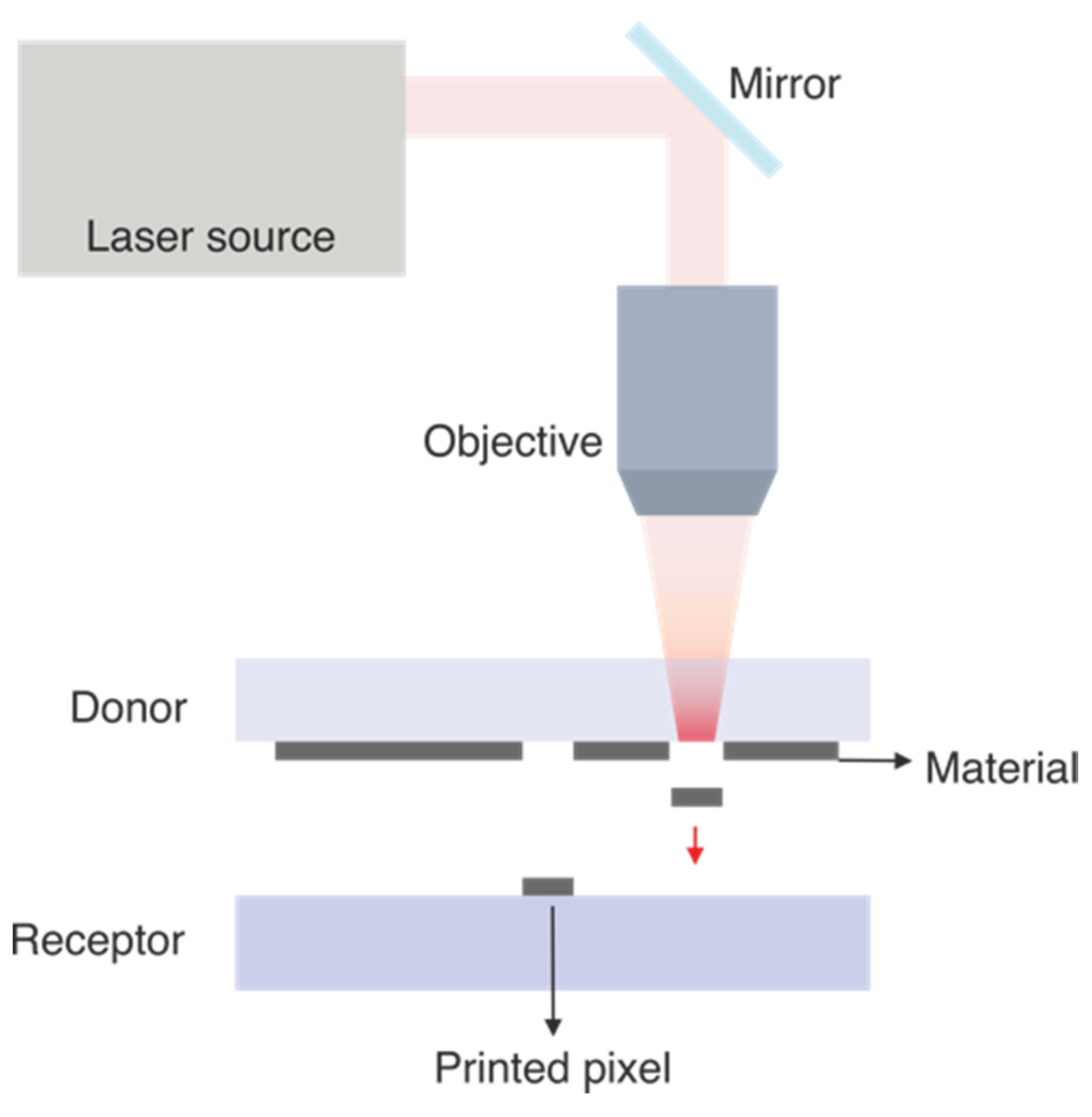
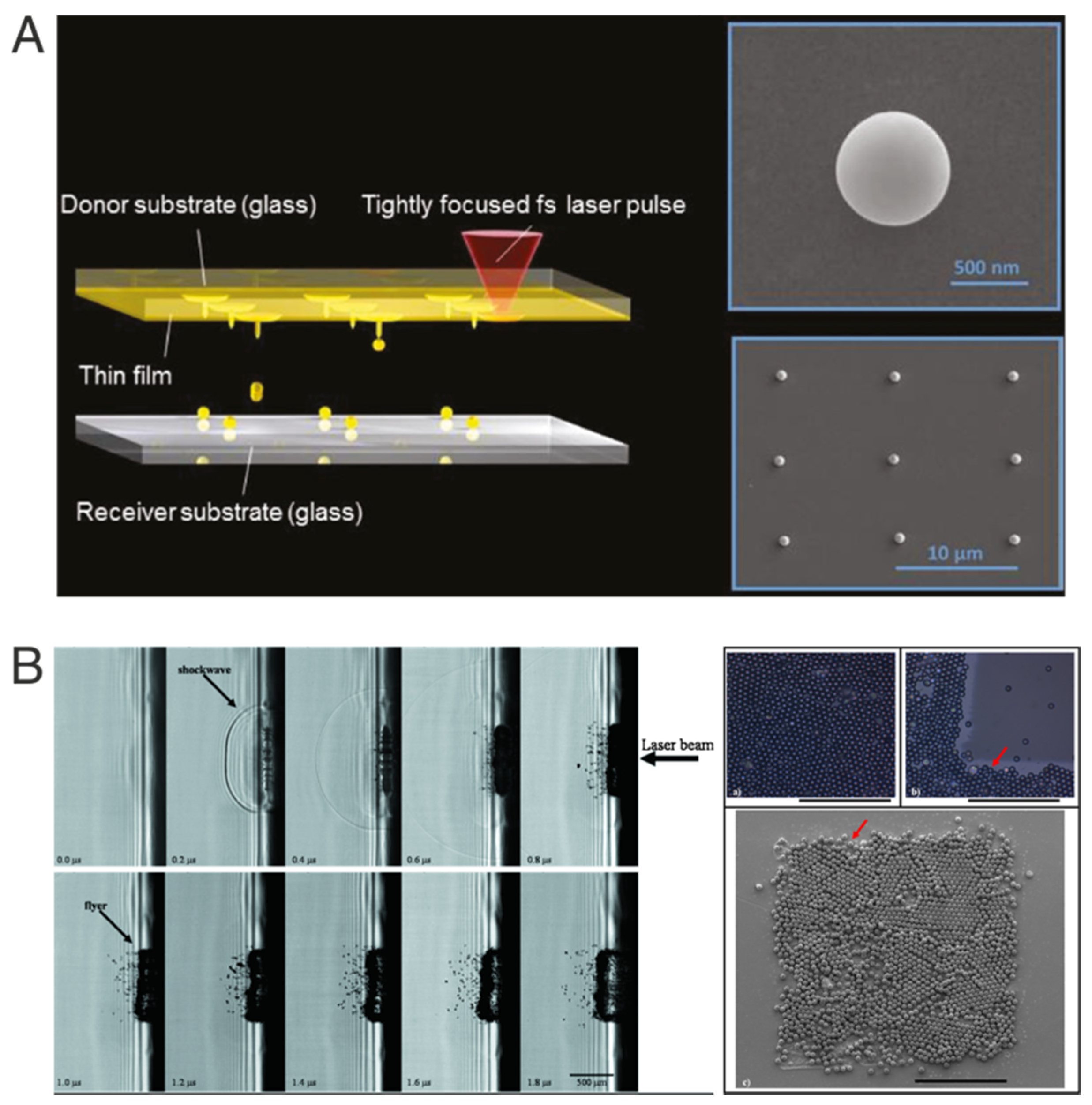
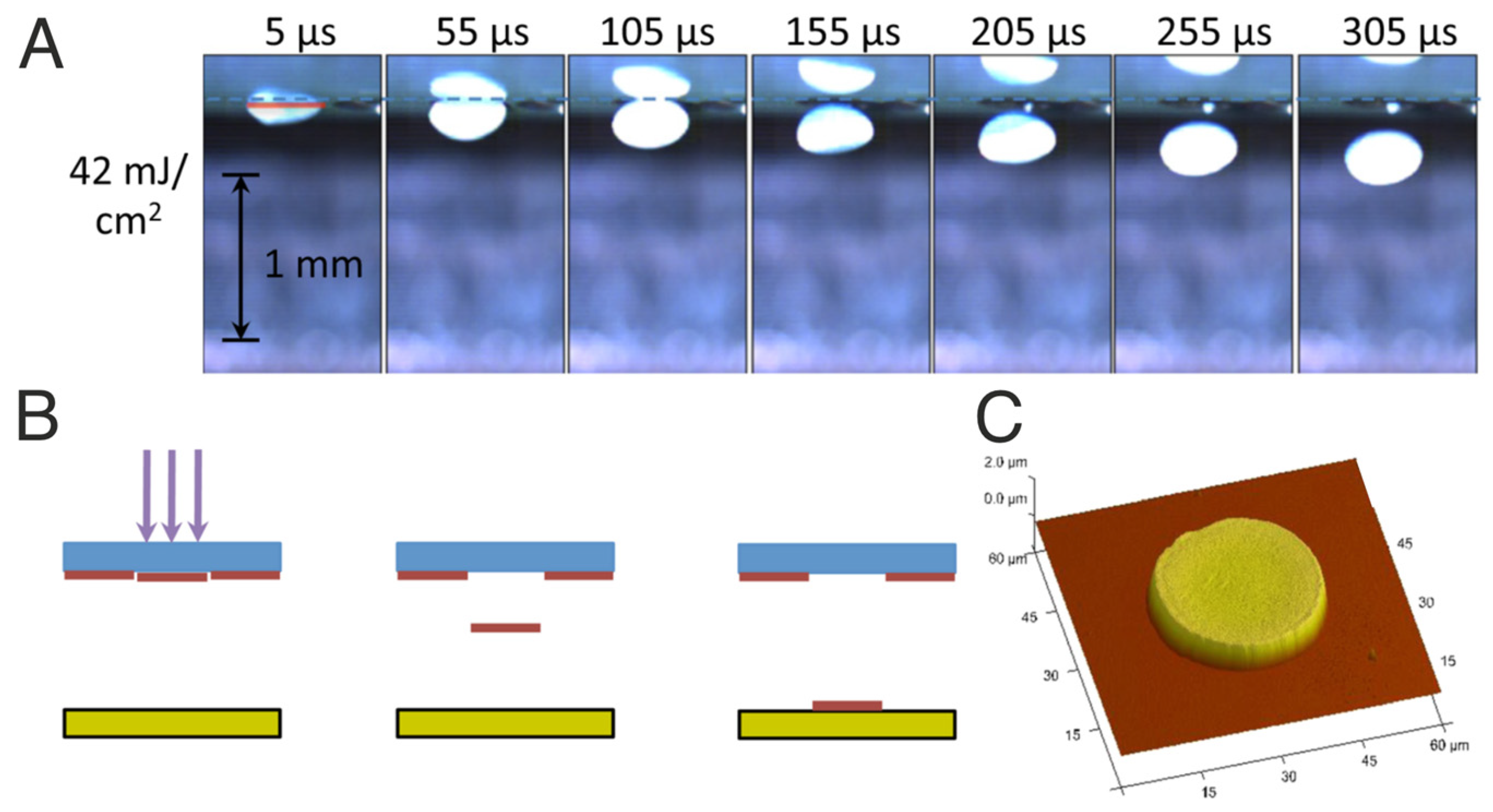
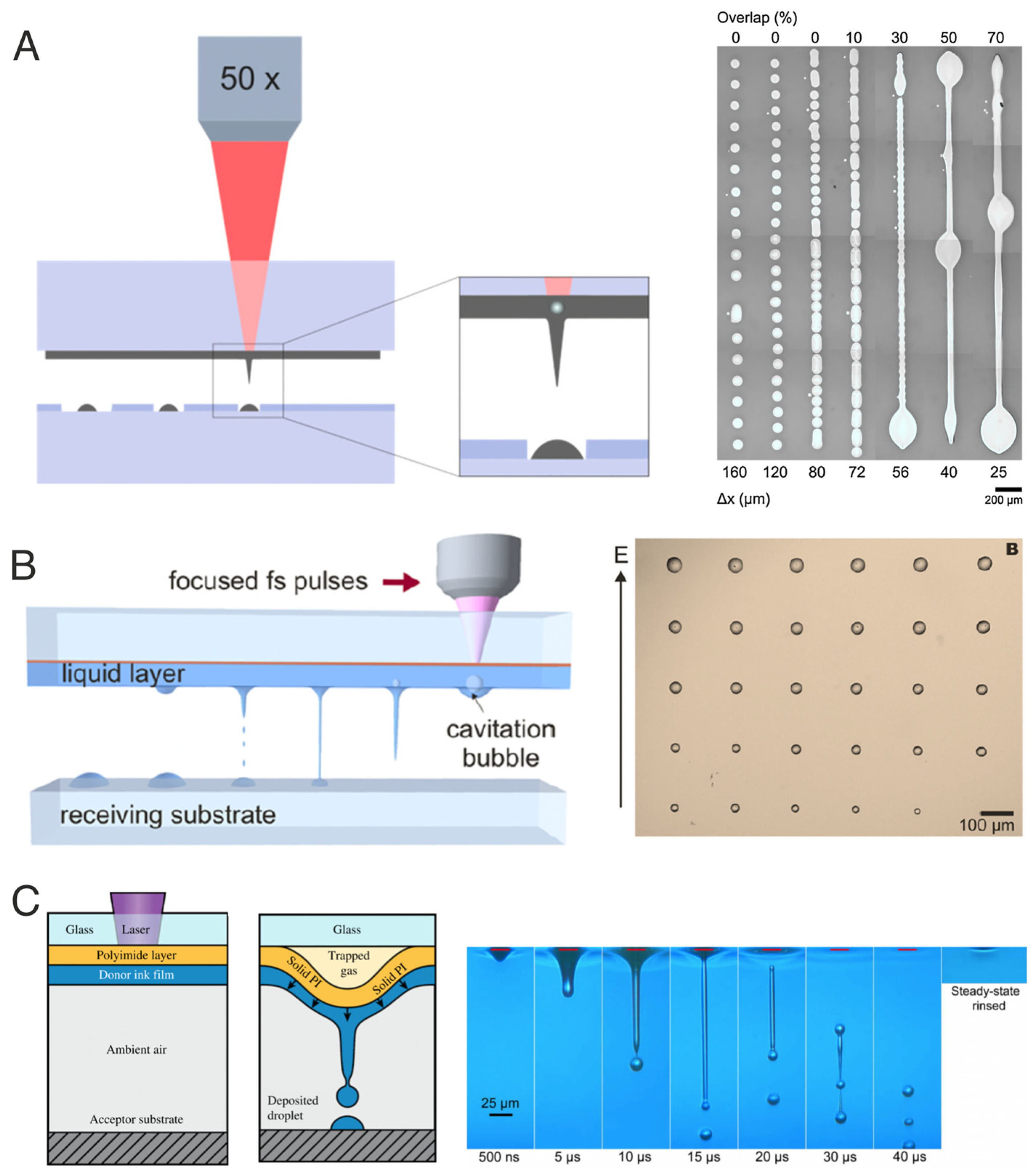
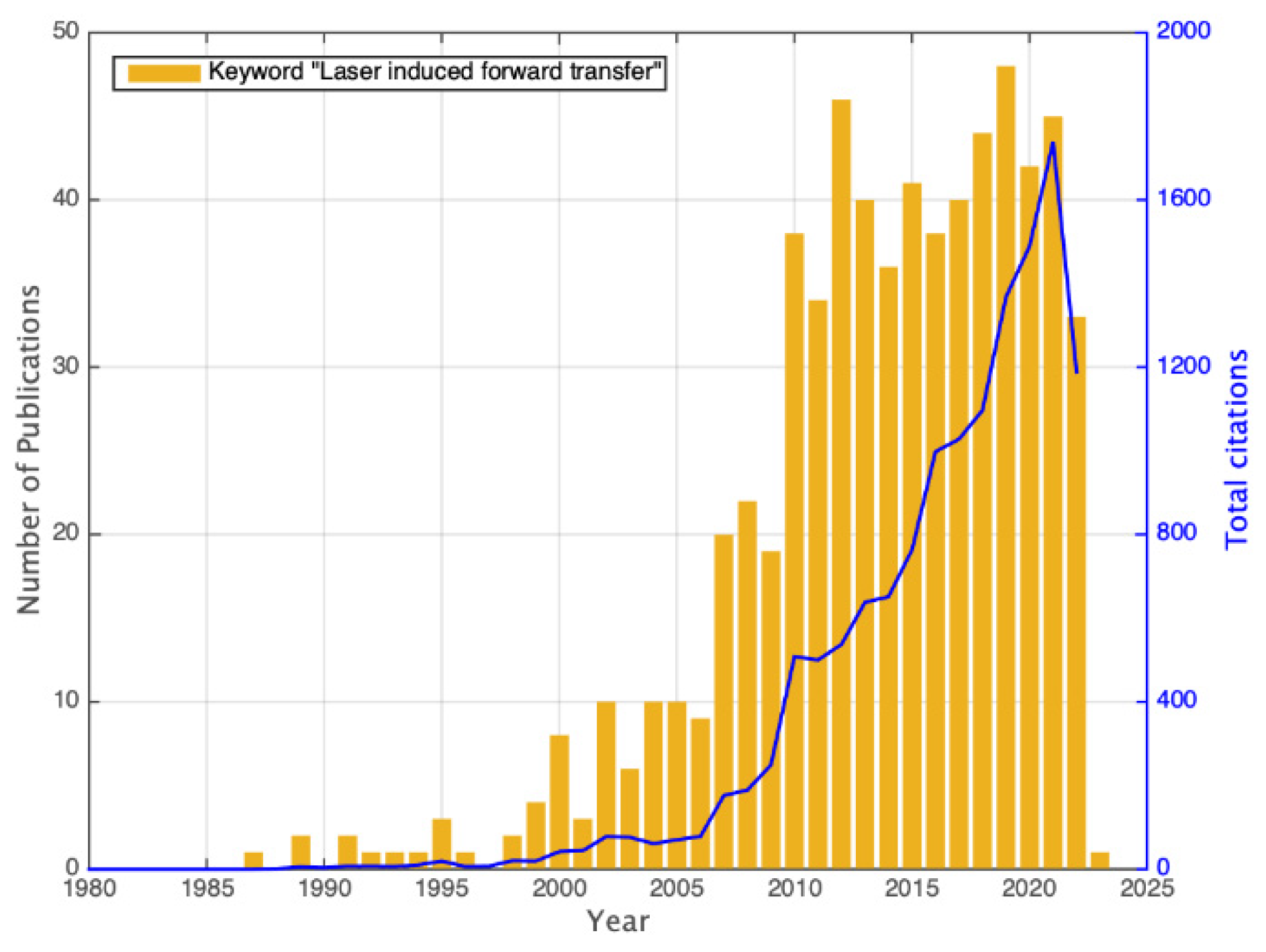


| Publication Name | Number of Papers | Percentage (%) |
|---|---|---|
| Applied Surface Science | 84 | 12.7 |
| Proceedings of the Society of Photo Optical Instrumentation Engineers SPIE | 59 | 8.9 |
| Applied Physics A Materials Science Processing | 48 | 7.2 |
| Applied Physics Letters | 24 | 3.6 |
| Journal of Laser Micro Nanoengineering | 21 | 3.1 |
| Optics Express | 14 | 2.1 |
| Journal of Applied Physics | 11 | 1.6 |
| Conference on Lasers and Electro Optics | 9 | 1.3 |
| Journal of Physics D Applied Physics | 9 | 1.3 |
| Nanomaterials | 9 | 1.3 |
| Institution | Country | Number of Papers | Percentage (%) |
|---|---|---|---|
| European Commission | European countries | 99 | 14.9 |
| National Natural Science Foundation of China | China | 34 | 5.1 |
| National Science Foundation | United States | 25 | 3.7 |
| German Research Foundation | Germany | 24 | 3.6 |
| Office of Naval Research | United States | 23 | 3.4 |
| Engineering Physical Sciences Research Council | United Kingdom | 21 | 3.1 |
| UK Research Innovation | United Kingdom | 21 | 3.1 |
| French National Research Agency | France | 19 | 2.8 |
| Spanish Government | Spain | 19 | 2.8 |
| Swiss National Science Foundation | Switzerland | 13 | 1.9 |
Disclaimer/Publisher’s Note: The statements, opinions and data contained in all publications are solely those of the individual author(s) and contributor(s) and not of MDPI and/or the editor(s). MDPI and/or the editor(s) disclaim responsibility for any injury to people or property resulting from any ideas, methods, instructions or products referred to in the content. |
© 2023 by the authors. Licensee MDPI, Basel, Switzerland. This article is an open access article distributed under the terms and conditions of the Creative Commons Attribution (CC BY) license (https://creativecommons.org/licenses/by/4.0/).
Share and Cite
Florian, C.; Serra, P. Printing via Laser-Induced Forward Transfer and the Future of Digital Manufacturing. Materials 2023, 16, 698. https://doi.org/10.3390/ma16020698
Florian C, Serra P. Printing via Laser-Induced Forward Transfer and the Future of Digital Manufacturing. Materials. 2023; 16(2):698. https://doi.org/10.3390/ma16020698
Chicago/Turabian StyleFlorian, Camilo, and Pere Serra. 2023. "Printing via Laser-Induced Forward Transfer and the Future of Digital Manufacturing" Materials 16, no. 2: 698. https://doi.org/10.3390/ma16020698
APA StyleFlorian, C., & Serra, P. (2023). Printing via Laser-Induced Forward Transfer and the Future of Digital Manufacturing. Materials, 16(2), 698. https://doi.org/10.3390/ma16020698





